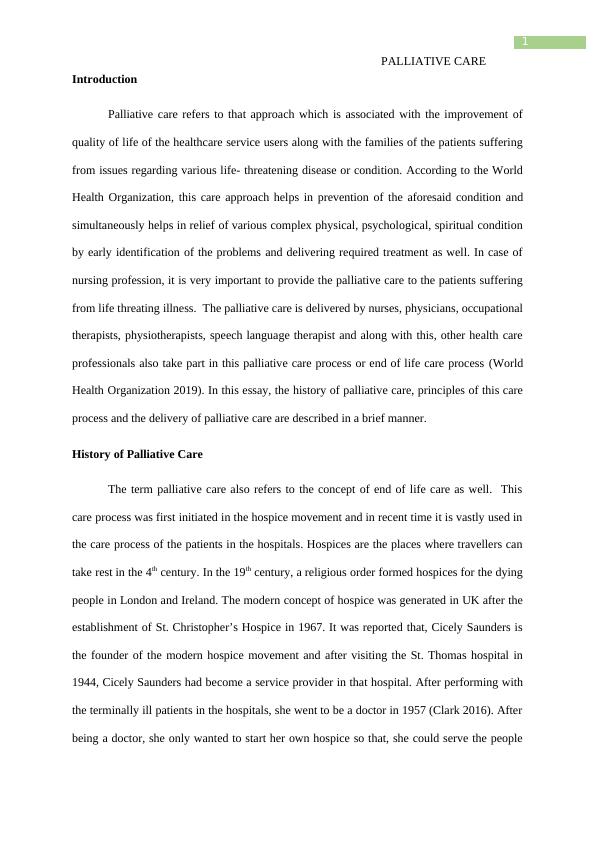Palliative Care: History, Principles, and Delivery
Added on 2022-12-20
7 Pages1709 Words65 Views
Running head: PALLIATIVE CARE
Palliative Care
Name of the Student
Name of the University
Author Note
Palliative Care
Name of the Student
Name of the University
Author Note

1
PALLIATIVE CARE
Introduction
Palliative care refers to that approach which is associated with the improvement of
quality of life of the healthcare service users along with the families of the patients suffering
from issues regarding various life- threatening disease or condition. According to the World
Health Organization, this care approach helps in prevention of the aforesaid condition and
simultaneously helps in relief of various complex physical, psychological, spiritual condition
by early identification of the problems and delivering required treatment as well. In case of
nursing profession, it is very important to provide the palliative care to the patients suffering
from life threating illness. The palliative care is delivered by nurses, physicians, occupational
therapists, physiotherapists, speech language therapist and along with this, other health care
professionals also take part in this palliative care process or end of life care process (World
Health Organization 2019). In this essay, the history of palliative care, principles of this care
process and the delivery of palliative care are described in a brief manner.
History of Palliative Care
The term palliative care also refers to the concept of end of life care as well. This
care process was first initiated in the hospice movement and in recent time it is vastly used in
the care process of the patients in the hospitals. Hospices are the places where travellers can
take rest in the 4th century. In the 19th century, a religious order formed hospices for the dying
people in London and Ireland. The modern concept of hospice was generated in UK after the
establishment of St. Christopher’s Hospice in 1967. It was reported that, Cicely Saunders is
the founder of the modern hospice movement and after visiting the St. Thomas hospital in
1944, Cicely Saunders had become a service provider in that hospital. After performing with
the terminally ill patients in the hospitals, she went to be a doctor in 1957 (Clark 2016). After
being a doctor, she only wanted to start her own hospice so that, she could serve the people
PALLIATIVE CARE
Introduction
Palliative care refers to that approach which is associated with the improvement of
quality of life of the healthcare service users along with the families of the patients suffering
from issues regarding various life- threatening disease or condition. According to the World
Health Organization, this care approach helps in prevention of the aforesaid condition and
simultaneously helps in relief of various complex physical, psychological, spiritual condition
by early identification of the problems and delivering required treatment as well. In case of
nursing profession, it is very important to provide the palliative care to the patients suffering
from life threating illness. The palliative care is delivered by nurses, physicians, occupational
therapists, physiotherapists, speech language therapist and along with this, other health care
professionals also take part in this palliative care process or end of life care process (World
Health Organization 2019). In this essay, the history of palliative care, principles of this care
process and the delivery of palliative care are described in a brief manner.
History of Palliative Care
The term palliative care also refers to the concept of end of life care as well. This
care process was first initiated in the hospice movement and in recent time it is vastly used in
the care process of the patients in the hospitals. Hospices are the places where travellers can
take rest in the 4th century. In the 19th century, a religious order formed hospices for the dying
people in London and Ireland. The modern concept of hospice was generated in UK after the
establishment of St. Christopher’s Hospice in 1967. It was reported that, Cicely Saunders is
the founder of the modern hospice movement and after visiting the St. Thomas hospital in
1944, Cicely Saunders had become a service provider in that hospital. After performing with
the terminally ill patients in the hospitals, she went to be a doctor in 1957 (Clark 2016). After
being a doctor, she only wanted to start her own hospice so that, she could serve the people

2
PALLIATIVE CARE
during their end of life. In US, the concept of hospice was initiated by the voluntary
movement and after that it was incorporated in the health care system as well. In US, the
hospice care was used to provide benefits in terms of medical services, pharmacologically, all
time services to the patients who are at the end of their life. Initially, this hospice care was
delivered at the home. Therefore, gradually this type of care entered in the nursing home
services, hospitals. The first hospital ,that initiated the palliative care services to the patients
was situated in US (Connor 2017). Therefore, the first palliative care program was designed
by Declan Walsh in 1987at the Cleveland Clinic Cancer Centre. It is reported that, this
integrated program was associated with various notable innovation in the health care sector
regarding palliative care in US. With the development of health care technologies, in 2009,
Norway become the first country in pan- Europe to develop a palliative care centre and end of
life care centre in the Trondheim. This centre was established at St. Olav’s Hospital and
NTNU’s faculty of Medicine. In UK, there were just 1700 hospice services in 2005 and it
comprised of 33 inpatient units for children with 255 beds, 220 inpatient units for adults with
3,156 beds, 263 day care services, 358 home care services, 104 hospice at home services and
293 hospital teams ( Clark 2016).
Principles of Palliative Care
While delivering palliative care to the patients, the nursing professional must follow a
few principles in order to provide a proper palliative care to the patients. A palliative care
includes a wide spectrum of care including the medical, psychological, cultural, social,
nursing and spiritual support to the patients. Apart from that, a holistic approach is also
required for providing a standard palliative care to the patients. According to the study of
Richardson, Percy and Hughes (2015), it is reported that, a caring attitudes of the nursing
personnel is one of the most common principles of palliative care. A caring attitude of the
nursing personnel may include the feelings of empathy, sensitivity and compassion that
PALLIATIVE CARE
during their end of life. In US, the concept of hospice was initiated by the voluntary
movement and after that it was incorporated in the health care system as well. In US, the
hospice care was used to provide benefits in terms of medical services, pharmacologically, all
time services to the patients who are at the end of their life. Initially, this hospice care was
delivered at the home. Therefore, gradually this type of care entered in the nursing home
services, hospitals. The first hospital ,that initiated the palliative care services to the patients
was situated in US (Connor 2017). Therefore, the first palliative care program was designed
by Declan Walsh in 1987at the Cleveland Clinic Cancer Centre. It is reported that, this
integrated program was associated with various notable innovation in the health care sector
regarding palliative care in US. With the development of health care technologies, in 2009,
Norway become the first country in pan- Europe to develop a palliative care centre and end of
life care centre in the Trondheim. This centre was established at St. Olav’s Hospital and
NTNU’s faculty of Medicine. In UK, there were just 1700 hospice services in 2005 and it
comprised of 33 inpatient units for children with 255 beds, 220 inpatient units for adults with
3,156 beds, 263 day care services, 358 home care services, 104 hospice at home services and
293 hospital teams ( Clark 2016).
Principles of Palliative Care
While delivering palliative care to the patients, the nursing professional must follow a
few principles in order to provide a proper palliative care to the patients. A palliative care
includes a wide spectrum of care including the medical, psychological, cultural, social,
nursing and spiritual support to the patients. Apart from that, a holistic approach is also
required for providing a standard palliative care to the patients. According to the study of
Richardson, Percy and Hughes (2015), it is reported that, a caring attitudes of the nursing
personnel is one of the most common principles of palliative care. A caring attitude of the
nursing personnel may include the feelings of empathy, sensitivity and compassion that

End of preview
Want to access all the pages? Upload your documents or become a member.
Related Documents
Palliative Care of Patients - Assignmentlg...
|7
|2003
|253
History And Principles of Palliative Carelg...
|5
|1448
|29
Development and Organisational Leadershiplg...
|11
|2931
|16
Nursing Public Health - Palliative and Hospice Care, Community Health Nurse Role, Ethical Viewpoint and Resource Uselg...
|5
|796
|61
Case Study and Care Plan for Nursing Practice and Palliative Carelg...
|11
|3694
|341
Palliative and Hospice Care - Assignmentlg...
|8
|2033
|48
